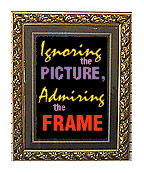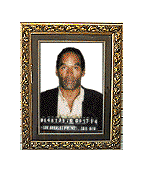
Framing II
Framing III
Framing IV
Framing V
Framing VI
Framing VII
Framing VIII
Ignoring the Picture, Admiring the Frame

Ignoring the Picture, Admiring the Frame

Imagine the following web pages are a sort of museum, and that I am your tour guide. This museum, however, isn't dedicated to the display of beautiful art. It is a museum of picture frames. That's right--as we tour the halls of this museum, we view frame after frame, all of them hanging empty on the walls. And as we walk, I point out to you the great variety of frames: ornate ones, simple ones, brightly colored ones, strong and weak frames, shallow and deep ones, some subtle, some garish. And now, we stop in front of a large, vivid frame. I tell you with obvious pride that this frame, only recently hung, is one of the most well-known frames of recent history, and that we are very fortunate to have procured it for our museum. As you stoop to read its title, you see it is called, "The Great O.J. Simpson Frame."
No, it has nothing to do with whether or not O.J. was 'framed,'
in the common sense of the word. This is, rather, the frame through
which the jury viewed the testimony in the O.J. Simpson trial.
Now let me tell you a little about this formidable frame:
 Despite disagreements among observers of
the O.J. Simpson trial, there's one point where pundits agree:
O.J. was acquitted by a jury that actively interpreted the evidence
they encountered. And that interpretation evolved as the trial
progressed.
Despite disagreements among observers of
the O.J. Simpson trial, there's one point where pundits agree:
O.J. was acquitted by a jury that actively interpreted the evidence
they encountered. And that interpretation evolved as the trial
progressed.
In the beginning, jurors were instructed to discover whether
or not O.J. Simpson had murdered his wife. The initial question
was framed as [O.J. innocent vs. O. J. guilty]. But both the
prosecution and the defense immediately attempted to reframe
the argument in terms of victimhood. The prosecution framed the
trial as [wife-beater male vs. female victim], while the defense
attempted to adopt the frame of [ethnic minority victim vs. racist
police force]. As any savvy lawyer could tell you, the outcome
of the trial depended on which frame became the one through which
the jury viewed the evidence. The frame determined how the jury
interpreted the missing bag, the trip to Chicago, the drops of
Ron Goldman's blood in O.J.'s car, the cut on Simpson's hand,
the bloody sock and glove, and O.J.'s blood on a gate near the
crime scene. One of two frames dominated, and the rest is history.
Most people had lingering questions after the Simpson trial.
For me, the fascinating questions that remained unanswered were:
how pervasive is this technique of framing? How is a frame successfully
made and retained? And how can one defend against information
that has been framed--in fact, how do you even know when you've
encountered framed information? With these questions in mind,
let's continue our tour through the
museum of frames.
www.workingpsychology.com
All rights reserved.
